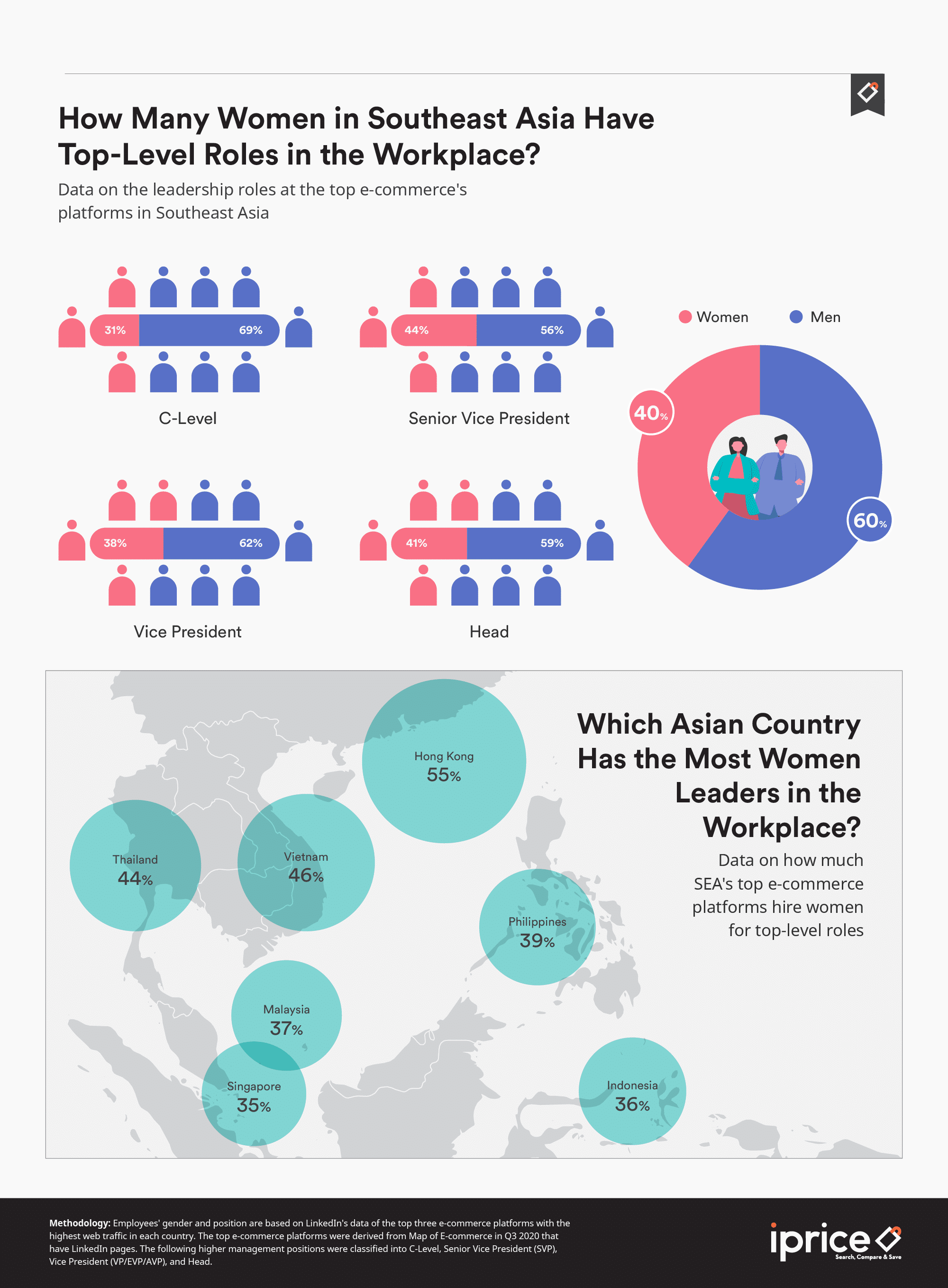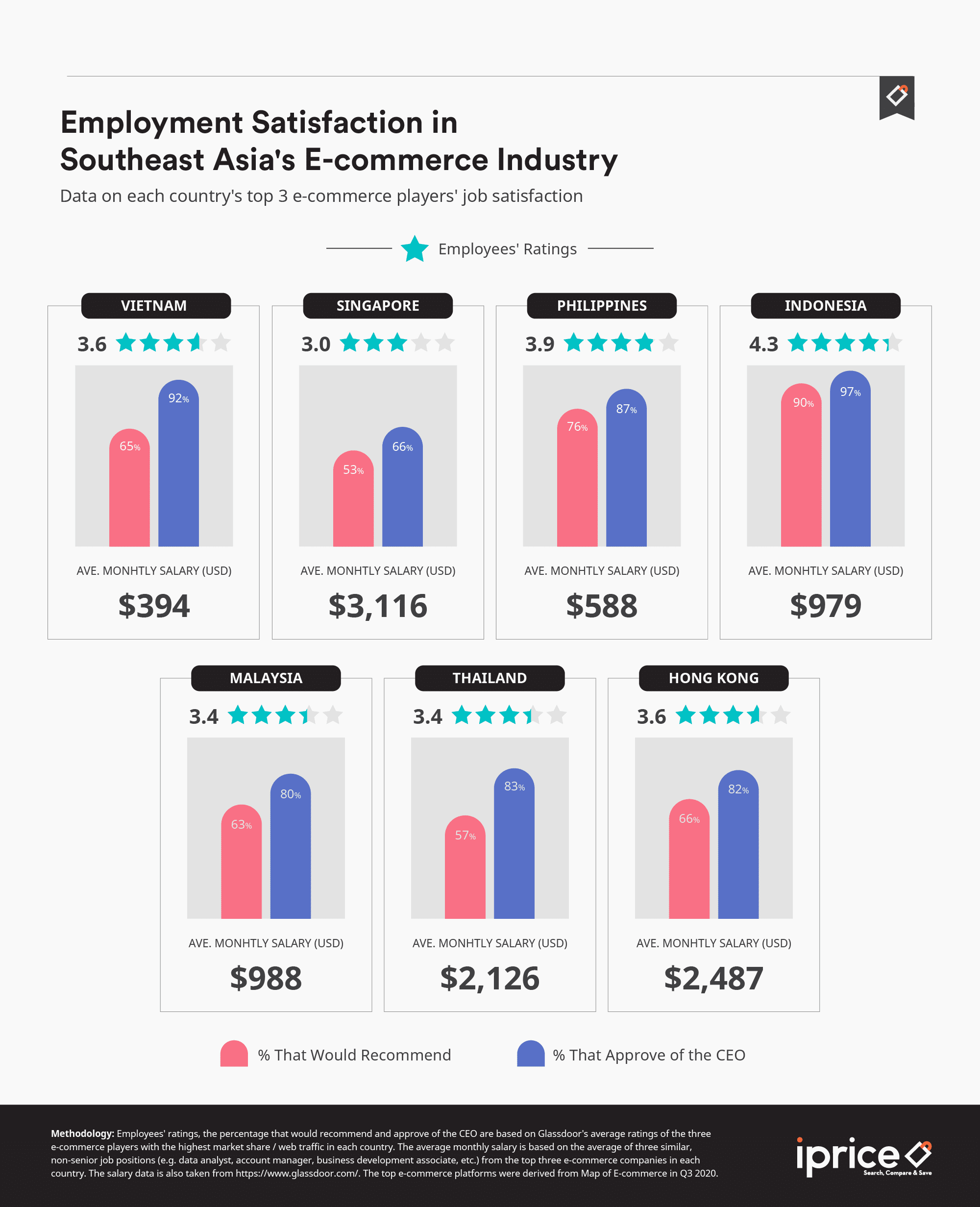e-Commerce is a fairly new industry. It arrived in Southeast Asia sometime around the ’90s, and only became what it is today, a rapidly accelerating economy, in the last decade. Thus, we may wonder if working in this young sector is any different than older, more developed industries?
Since e-commerce is a place for the internet-savvy, are we expected to see the millennials’ and Gen Z’s work ethics more in this sector? Can we see more gender diversity in top-level roles? Hence, iPrice Group gathered data to determine the gender diversity and job satisfaction rates of the top three e-commerce companies in 7 countries in Asia.

Gender Diversity in Top-Level Roles
It’s crazy to realize how women just gained the right to vote about a hundred years ago. These days, however, we’re starting to see women climb up the career ladder on the same top-level roles as men.
Nonetheless, the disparity is still present due to many years of women’s unconscious bias to be family-oriented. In Southeast Asia’s e-commerce, we can see quite a gap in certain top-level roles, especially at the C-level position. Only 31% of women have C-level roles, while 69% of these titles are held by men.
The same goes for the Vice President positions. 62% of Vice Presidents in Southeast Asia’s top e-commerce companies are men, while only 38% are women.
However, when it comes to Senior Vice President (SVP) roles, the gap is smaller. 44% of the top e-commerce SVPs are women while 56% are men. Similarly, the gap is smaller in department head roles. 41% of these roles are taken by women, while 59% are taken by men.
Overall, there is a 60-40 disparity between men and women when it comes to being in positions of power. Given centuries of gender inequality and women taking time off for child rearing, the disparity isn’t as wide as we may have assumed.
Comparing all 7 seven countries, Hong Kong has the highest percentage of women in power in the top e-commerce companies in Southeast Asia, where 55% of the top-level roles are actually women. Vietnam and Thailand trail behind Hong Kong at 46% and 44% respectively.
Surprisingly, in the Philippines, only 39% of these top-level positions are held by women, while in iPrice’s previous study in 2018, the Philippines had the most women in top-level positions.
Malaysia (37%), Indonesia (36%), and Singapore (35%) have the least women in power in Southeast Asia.
Job Satisfaction in Southeast Asia’s Top E-commerce Companies
Overall, employees don’t seem to loathe working in the e-commerce industry of Southeast Asia. In all seven countries, the ratings are average to above-average (from a 3-star to a 4.3-star rating). Half or more of these employees would recommend e-commerce companies as a workplace to their friends, while e-commerce CEOs have really high approval ratings (66-97%).
Indonesians are the most satisfied with the e-commerce industry as a workplace. According to iPrice’s data gathered from Glassdoor, Indonesians give these e-commerce companies a 4.3-star rating. 90% of the participants would recommend these companies to a friend, while 97% of them approve of their CEOs.
The next most satisfied employees are Filipinos. They give their top 3 e-commerce companies a 3.8-star rating, while 76% of them would recommend the companies to friends, and 87% of them approve of their CEOs. It’s quite interesting since the Philippines has one of the lowest recorded salaries (US$588/mo) among the seven countries, right after Vietnam (US$394/mo).

Despite having the highest salary among the seven countries (US$3,116/mo), Singaporeans seem to be the most unsatisfied with working in the top e-commerce companies. Participants of Glassdoor only gave an average of 3-stars to the top three e-commerce companies in Singapore. Only a little more than half of them (53%) would recommend these companies to a friend, and only 66% of them approve of the CEO.
In Conclusion: Southeast Asia’s E-Commerce Industry is Not a Bad Place
With iPrice’s aggregated data, it seems that this young industry does hold the value of its employees by gaining at the very least, an average satisfaction rate among its employees. Lastly, it doesn’t seem to discriminate gender as well, given the total gender disparity among top-level roles is not so wide (60-40). The future seems to be bright in a new industry like e-commerce, where there are more empathy and less discrimination to its employees.
To view the official study, click here.
iPrice curates highly insightful data that are unique and unbiased in the world of tech, e-commerce, and online retail by providing data-rich, interactive, and media-specific targeted content that varies from the latest tech trends to the top e-players in Southeast Asia. They also provide high-quality country-specific insights and data on seven markets, namely Singapore, Hong Kong, Vietnam, Thailand, Indonesia, Malaysia, and the Philippines. Through collaborations with data partners such as App Annie Intelligence, SimilarWeb, and Parcel Perform, iPrice has been featured on numerous prominent publications including South China Morning Post, Bloomberg, Motley Fool, Nasdaq, IGN, and Tech Crunch, to name a few.



















